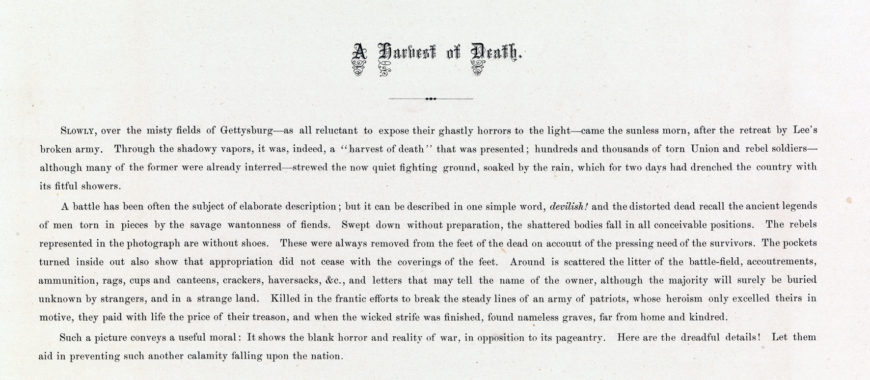Test your knowledge with a quiz
O'Sullivan, A Harvest of Death
Important concepts
- war photography
- collodion process
- The Civil War and the Battle of Gettysburg
Key points
- The Union Army’s victory at the Battle of Gettysburg in early July 1863 was a turning point in the Civil War, although it brought the highest death toll of any battle in the 4-year conflict. Abraham Lincoln’s Gettysburg address at the Gettysburg National Cemetery in November of that year reinforced the incredible sacrifice of those who gave their lives to the cause of national unity.
- War photography was a relatively new endeavor at the time of the U.S. Civil War. Photographers required heavy equipment and time-intensive processes like the wet collodion method to capture images, making it difficult to take action shots during battles. Instead, they staged scenes, at times moving people, equipment or other items and crafting a composition much like a planned painting or drawing in order to tell a compelling narrative.
- In comparison to precedents of military victory scenes, A Harvest of Death is unusual. It focuses on the horrors of death on the battlefield rather than a decisive moment of heroism or victory during battle. Nonetheless, the photographer relies on conventions of landscape painting such as one point and atmospheric perspective, along with a dramatic, layered composition leading the eye from foreground to background, to draw in the viewer and convey a powerful, unforgettable message about this historic event.
- This photograph was included in Gardner’s Photographic Sketch Book of the War (1866). Each photograph had a lengthy caption that explained what was captured in each scene.

Gardner’s Photographic Sketch Book of the War, 1866 (The Metropolitan Museum of Art)
For the “Harvest of Death” photo the caption read: “It was, indeed, a ‘harvest of death.’ . . . Such a picture conveys a useful moral: It shows the blank horror and reality of war, in opposition to its pageantry. Here are the dreadful details! Let them aid in preventing such another calamity falling upon the nation.”
Go deeper
The Gettysburg Address—setting and context, with Dr. Kimberly Kutz Elliott
The Gettysburg Address—full text and analysis, with Dr. Kimberly Kutz Elliott
See more photos from Alexander Gardner’s Photographic Sketch Book of the War at the Met
Learn more about the wet plate photography process from PBS
William A. Frassanito, Gettysburg: A Journey in Time (Scribner, 1975), and Early Photography at Gettysburg (Thomas, 1996).
D. Mark Katz, Witness to an Era: The Life and Photographs of Alexander Gardner (Rutledge Hill Press, 1999).
Richard S. Lowry, The Photographer and the President: Abraham Lincoln, Alexander Gardner, and the Images that Made a Presidency (Rizzoli, 2015).
More to think about
Which is more powerful for you, images of heroism or death in battle? Why?
Research project ideas
- Explore the photographic processes of the mid-19th century, especially war photography. Why was the advent of battlefield photography so revolutionary in communicating and understanding the realities of war? Was there anything unexpected to you about how this photograph was made? What felt familiar to you, if anything? Use your responses to reflect on the differences between the production and reception of war images in the 1860s and today.
- Considering change over time, explore a broader array of images that address the experience of wartime in the U.S. Compare Harvest of Death with Edward Hopper’s Nighthawks (1942) and James Rosenquist’s F-111 (1964). Note that Nighthawks was completed just after the Japanese bombing of Pearl Harbor and the implementation of periodic blackout drills in New York City as the U.S. entered World War II. F-111 was painted during the Vietnam War.





